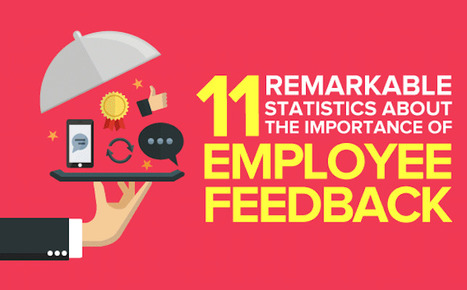 Your new post is loading...
 Your new post is loading...
There’s a great quote from Confucius: “Tell me, and I will forget. Show me, and I may remember. Involve me, and I will understand." People will more readily help bring to life the changes that they are involved with. How are you involving your people in the changes that need to be implemented?...
We surveyed approximately 9,800 full-time workers, ages 19 to 68, in Brazil, China, Germany, India, Mexico, Japan, the UK, and the U.S. Our most striking finding was that fewer than half of all surveyed professionals have a high amount of trust in their companies: Only 46% place “a great deal of trust” in their employers, and 15% report “very little” or “no trust at all.” (The rest, 39%, say they have “some trust,” which is not completely pessimistic but does want for enthusiasm.) There clearly is room to improve for all of us, and companies (including EY) should pay attention to what’s discouraging the most distrusting group of workers. Among those with little or no trust in their employer, the top five reasons were: “Employee compensation is not fair,” their employer “does not provide employees with equal opportunity for pay and promotion,” there’s a “lack of strong senior leadership,” “too much employee turnover — voluntary and/or involuntary,” and the employer does not foster a “collaborative work environment.”...
Days after taking over as Twitter’s permanent CEO, Jack Dorsey has laid off 336 people. You could learn a lot from the straightforward, honest, and sensitive way he tells his company about it.
The corporate layoff is a communications trap for leaders. It makes them insecure, so they they adopt HR bullshit and talk about “reduction in force”, “rightsizing”, “eliminating positions.” But they don’t have to. Here’s how Jack Dorsey told Twitter he was letting a big chunk of the company go....
It's every manager's responsibility to provide meaningful feedback on a regular basis. And that doesn't mean waiting for the annual review to roll around: Employees that are highly engaged at work receive employee feedback at least once a week.
But giving feedback regularly isn't just beneficial for the employee -- it's beneficial for the team, too. Did you know that receiving feedback can actually inspire your employees to work harder and become more engaged? In fact, 69% of employees say they would work harder if they felt their efforts were being better recognized. Employees who receive little or no feedback from their managers tend to disengage from their work more readily....
So often we can feel like we are drowning in a sea of monotony. Find a cause that makes you want to wake up every morning and change the world.
... Having a role is good. Doing well feels great. Being acknowledged for a job well done feels even better. That sensation we get when we do something right and you know that everyone around is thinking, “dang, you go!” instills a sense of pride that no one can take away.
That feeling can be hard to come by. So often we can feel like we are drowning in a sea of monotony. So many of us start work thinking that this is going to be the right place to work and you work there and it turns out your boss is a jerk or your coworkers suck or it’s just not what you wanted. Quitting usually seems like the best option at that point. That is okay!..
|
Leaders of reorgs typically fall into one of two traps when communicating with their employees. We’ll call the first one wait and see and the second ivory-tower idealism. Perhaps you have seen one, or both, in your own reorgs.
In the first trap, wait and see, the leader of the reorg thinks everything should be kept secret until the last moment, when he or she has all the answers. The leader makes the reorg team and leadership swear to secrecy and then is surprised when the news leaks to the wider organization (it always does, we’re afraid). As the reorg team starts to engage with the rest of the organization, the rumors round the water cooler increase: “They were asking what my team does”; “I had to fill in an activity analysis form”; “I hear that 20 percent of jobs are going to go.” Everyone thinks the real reason for the reorg is job losses (whether it is or not). The leader, desperate to get in control of the situation, pushes the team to develop “the answer” so that he or she can tell the organization. Without an “answer,” the leader feels that any communication would come across as defensive. At most, the executive approves some question-and-answer sessions on the reorg. But a full-scale communication needs to wait. Eventually, the leader has the answer: the reorg team produces a high-level org chart. The leader then announces the new organization: here are the new leaders, here is the structure, some job losses are necessary, but this is going to help us deliver fantastic results. Employees, hearing this, hear only that their boss’s boss’s boss is going to change and that some of them are going to lose their jobs. Nothing their leader has said counters the impressions they formed at the water cooler.
Ivory-tower idealism fares little better. In this version, the leader of the reorg is finally getting a long-achieved objective: all the issues of the old organization will finally get fixed; everything the leader wanted to do, but was held back from, can now be achieved. The leader can barely contain the excitement. So psyched up by the possibilities that the reorganization offers, the leader decides to start the process with a webcast to all staff, telling them about the exciting business opportunities it will open up. The leader follows this up with a series of walk-arounds in the major plants and offices, discussing the opportunities and getting input on some of the challenges that people face in the organization today. The leader puts a personal blog on the company intranet....
Work customs and culture vary from country to country. For instance, meeting attendees in the U.S. seat themselves in no particular order around the conference table. But if the most junior person on the team were to take the seat farthest from the door in Japan? That's a no-no. This behavior flies in the face of Japanese custom, where the seating arrangement is determined by professional seniority (the most senior people sit farthest from the door, and the most junior people closest). But while there are no doubt differences in work styles around the world, there are also similarities. After surveying nearly 200 leaders located in 15 different countries, Quantum Leadership Group recently discovered the most important leadership trait worldwide: High ethical and moral standards.In a Harvard Business Review article covering the data, Sunnie Giles, president of Quantum Leadership Group, categorized this response along with the third most important trait ("clearly communicates expectations") as qualities that "creat[e] a safe and trusted environment."...
The infographic that we put together has some pretty shocking statistics in it, but there are a few common themes. Employees feel overworked, overwhelmed, and they don’t like what they do. Companies are noticing it, with 75% of them saying they can’t attract the right talent, and 83% of them feeling that their employer brand isn’t compelling. Companies that want to fix this need to be smart, and patient.
This doesn’t happen overnight, but like I mentioned, it’s easy to do. Being patient might be the hardest thing for companies, and I understand how frustrating it can be not to see results right away, but it’s important that you invest in this, because the ROI of employee engagement is huge.
Here are 4 simple (and free) things you can do to get that passion back into employees. These are all based on research from Deloitte....
Though end-of-year bonuses once stood as the gold standard, today's reward programs are more varied and reflect an organization's unique culture and creativity.
From peer-to-peer rewards to gamification and front-row parking spots, reward programs are evolving with the speed of an Internet meme. Your own incentive program plays a key role in driving innovative behavior, so it must serve your business goals while offering an array of aspirational carrots....
|



 Your new post is loading...
Your new post is loading...






![10 Shocking Statistics About Employee Engagement [infographic] | Public Relations & Social Marketing Insight | Scoop.it](https://img.scoop.it/alpzFdNyh6qsujxJDb0vBjl72eJkfbmt4t8yenImKBVvK0kTmF0xjctABnaLJIm9)
![#1 Most Important Leadership Trait Worldwide [New Research] | Public Relations & Social Marketing Insight | Scoop.it](https://img.scoop.it/vgzkn_Ad1P5VA3FyUoDE2zl72eJkfbmt4t8yenImKBVvK0kTmF0xjctABnaLJIm9)







People resist being forced to change without their involvement. This article talks about the best way to get everyone on board in times of change.